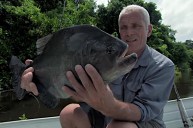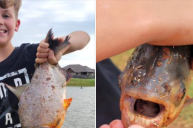You know how if you throw pop rocks into some cola, it starts to fizzle? Well, it turns out that you get the same effect if you throw a severed cow's head into a river with piranhas.
In a video shared by TikToker Paulo Vitor Noronha Alves, a man tosses what looks like a cow's head into a river. For a few moments, it just floats in the water. Then all of a sudden, the frenzy begins.
At first, it's like Alka Seltzer in water. It's misty and white, but then, the surrounding water turns red. The camera zooms in and you can see little fish popping out of the water. But it doesn't stop there.
Next, a little reptilian creature pops its head out of the water while chewing on a fish, and then, another one darts across the water. It dips its head under the frenzy and pops up on the other side with a fish in its mouth.
View this post on Instagram
Besides some preliminary details — the video was posted on June 19 and has garnered hundreds of views and nearly 72,000 likes — very little is known. In the comments, people debate exactly where this happened. Many deduce it's somewhere along the Amazon River, where piranhas are common.
It also generated a good question. One person asked: "Ok, so who do I believe? The Discovery Channel, who tells me piranhas won't eat me, or this video, showing me very clearly that piranhas WILL eat me?"
Will Piranhas eat you?
If you replace a severed cow's head with, say, your arm, will piranhas eat it? Experts say the answer is probably not. According to the Smithsonian, people might believe that piranhas will attack them because of how they're portrayed in movies, but the reality is there's not much evidence to support that claim.
More often than not, people who swim in piranha-infested waters emerge unscathed. "For swimmers, the danger comes when the water level is low, prey is scarce, or you disturb its spawn buried in the riverbed—basically situations where the fish either feel really threatened or really hungry, and thus become more aggressive," the article says.




